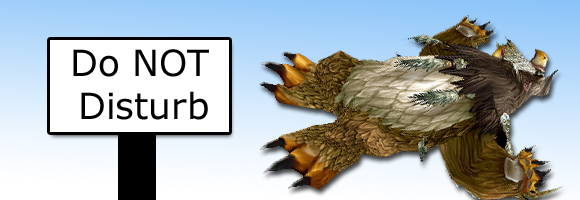I have been reading numerous posts lately about how to pick a strategy for an upcoming boss fight and even more discussion about how to go about tailoring a strategy to your particular group. While I have read many good suggestions and valuable tips, I still think I disagree with the the basic premise of “choosing which strategy is best for your group.” The portion related to tailoring your approach based on your specific group is good, but the vast majority of the time, boss fights have one basic strategy that they were intended to be completed with. Everything else is a modification of the basic strategy. Each decision to make additional modifications should be for a specific and, more importantly, *intentional* reason.
Here are the basic reasons for modifying a boss strategy. Whether it be during the research stage, during an actual raid, or after a full night of raiding, once you get some logs, a little perspective will help with the decision making process.
Wait! I can think of examples of multiple strategies used for bosses!
No, I actually put a fair amount of consideration into that statement. For the most part, all WoW raid bosses have one basic approach/strategy that everyone used to defeat them. That being said, almost every group that originally “progressed” through the boss fight made certain modifications to this basic strategy in order to adopt it to the particulars of their own group and situation. Generally though, each boss encounter has a single strategy/approach that is dictated by the mechanics of the encounter. Far too often I see people confusing two different modifications to the one basic strategy as somehow being completely separate from each other. Understanding where something comes from is an essential step in the road to gaining mastery over it.
For example: in the Yogg Saron fight, the basic strategy required to complete the encounter is to kill sarah by blowing up adds next to her, then you send people through the portals to damage the brain, finally you kill Yogg himself all while dealing with the various adds/abilities/”bad stuff.” Whether you tank the adds in phase1 in the center of the room next to Sarah, or tank them by the door and then kite them into the center is a difference in tactics, the strategy is the same. Who you send into the portals during phase 2 is a question of assignments, the fact of the matter is though, in order to get to phase3, you send some people into the portals and they have to damage the brain to push through the phase while everyone else does stuff to stay alive. In phase 3 you can tank the adds over here, over there, all grouped up or separated out, the individual assignments and tactics used will vary from group to group and depend on a number of factors but the basic strategy used to complete the fight is always going to be the same.
Reasons for modifying your strategy
You overgear or “out-awesome” one or more of the basic mechanics of the fight.
I’m not going to spend much time on this one although I think it is the most prevalent reason for differences in strategies being discussed. 10 man Sartharion 3D is a great example of this as is Yogg+0. Both are highly technical fights with what were some very unforgivable mechanics when they were “current content.” With access to greater gear and higher performance numbers from your average raider, it became possible to ignore the majority of these encounters core mechanics and opened up access to “new strategies” (and again, I am arguing that it is the same basic strategy to kill the boss, you are just choosing to ignore/skip a portion of it) It is important to be aware however if you have chosen to ignore one of the basic mechanics of the encounter. This can often be especially important when you get to the point of switching the encounter to hard mode or try and work on one of the raid achievements. If you have only learned how to do the fight using some kind of short cut or something that ignores a basic mechanic, then forcing yourselves to relearn the fight is often times a tough sell for the raid leader and a frustrating experience for your raiders. My advice is to learn to do it “right” the first time through.
You are missing some sort of raid utility buff/skill integral to the fight.
A lot of fights require something to be purged, dispelled, stunned, interrupted, etc… Especially when you are doing 10man raiding, it isn’t impossible that you will find yourself without one of these things while standing in front of a boss who “requires” that skill. Thankfully Blizzard is aware of this possibility and usually provide some method to address the issue. For one, they have spread around all of the basic raid utility skills so that the likelihood of finding yourself in this position has gotten MUCH less likely. In the past, they have usually toned down the adverse effects of the ability in case you don’t have the ability to purge/interrupt/cleanse each one.
One example of this for us in ICC were the occasions we found ourselves in front of Saurfang with 3 melee and no hunter to distracting shot kite one of the adds. We have done this fight with just about every composition of range and melee possible at this point, and our raiders have pulled all of them off without any more struggle than we were having at the time with “optimal” setups. Another example is when we were progressing through Naxx 25 and reached Instructor Razuvious without any priests in the raid, sorting out how to do that was an adventure all in itself.
The plan isn’t working
You outlined the plan on the guild forums ahead of time, you gave a brief synopsis over vent before you started, why isn’t the boss dead yet? Being able to accurately articulate the answer to “why isn’t this working” is a critical step that a surprising number of people get wrong in my experience. Here are some questions to ask yourself when trying to figure out the answer to this question:
How many times have you attempted the fight already this raid using this plan? If the answer is less than ~15-20, then unless you either clearly misunderstood some mechanic during your research, you probably need to collect more data. Unless you feel that everyone in the raid is executing the plan exactly the way they were asked, keep trying.
At what point in the fight did the group diverge from “the plan?” Was it a milestone you failed to meet? Unless everything went exactly as it was supposed to and your dps are putting out the same numbers they always do, you probably just need to let everyone work out their own kinks with some more practice. Depending on the type of milestone involved, possibly consider things like switching between 2 and 3 healers.
Are people dying? Every raid leader should have some sort of death tracking addon installed so you can easily review what caused people to die and what happened to them in the ~15 seconds prior to death.
- Tank death: did they use their defensive cooldowns appropriately? Were they where they were supposed to be? How much healing did they receive during their last ~10 seconds alive? If the healing received looks low, all appropriate cooldowns were used, and they were not out of healing range for some reason, it might be a “healing issue.”
If the healers weren’t healing the tanks, then what were they doing?
Were they all moving or unable to heal for some reason, maybe the positioning needs to be changed.
Were they healing someone else/themselves? Then those people need to get better at avoiding damage and your healers need to either have better healing assignments or different healing priorities. This is one of the biggest mistakes I see raid leaders make in blaming the healers for people dying when in reality it is the healers being forced into a no-win decision in to try and compensate for other people’s mistakes. Find out why they weren’t keeping the tank alive.
- Healer death: were they standing somewhere they weren’t supposed to be? Did someone fail to taunt/CC an add that killed the healer? …there shouldn’t really be any other reason for the healer to have ever died. Keeping themselves alive, followed closely by keeping the tank/their assignment alive is every healers only real responsibility in most fights.
- DPS death: Were they standing where they weren’t supposed to be? Did they pull aggro on something they weren’t supposed to? If they weren’t killed via a one-shot, how much healing did they receive before they died?
If you can’t figure out why your plan is failing and the boss isn’t dying, then your biggest problem isn’t with the plan you are using. Thankfully there are a wealth of resources available to you as a raid leader and a truly amazing number of members in the various raid leading communities that are just waiting to help you figure it all out. All you have to do to find help is be able to do is follow two simple steps:
- Generate a combat log during your raid and upload it to one of the available *free* services that will parse the information into a useful format. My personal preference is World of Logs.
- Ask someone for help. Everyone starts out as a newbie at some point, none of us are born with the ability to play wow or lead raiders. Some of us still remember what it was like starting out and we are more than happy to offer help. Being able to provide a log of the your raid attempting the encounter in question will allow FAAARRR more useful feedback then trying to communicate all of the details through any other method.
Have you ever had a boss kill which came from a simple, yet overlooked strategy modification?




